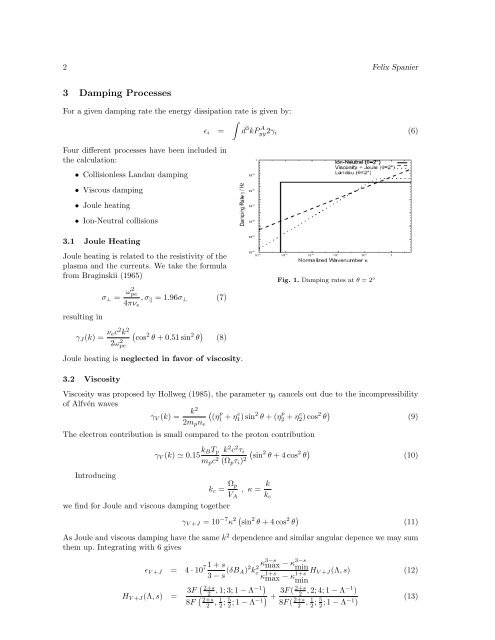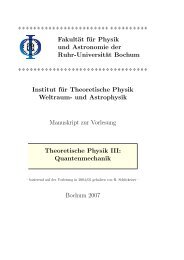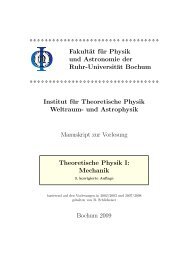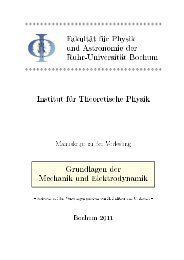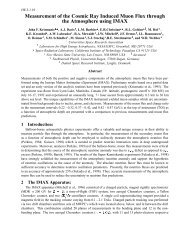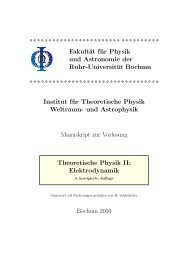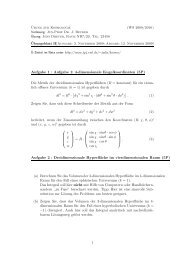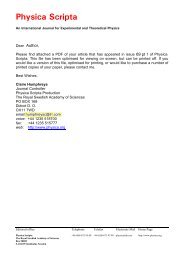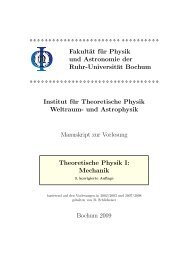Heating of the ISM by Alfvén-wave damping - Theoretische Physik IV ...
Heating of the ISM by Alfvén-wave damping - Theoretische Physik IV ...
Heating of the ISM by Alfvén-wave damping - Theoretische Physik IV ...
You also want an ePaper? Increase the reach of your titles
YUMPU automatically turns print PDFs into web optimized ePapers that Google loves.
2 Felix Spanier<br />
3 Damping Processes<br />
For a given <strong>damping</strong> rate <strong>the</strong> energy dissipation rate is given <strong>by</strong>:<br />
∫<br />
ɛ i = d 3 kPyy2γ A i (6)<br />
Four different processes have been included in<br />
<strong>the</strong> calculation:<br />
• Collisionless Landau <strong>damping</strong><br />
• Viscous <strong>damping</strong><br />
• Joule heating<br />
• Ion-Neutral collisions<br />
3.1 Joule <strong>Heating</strong><br />
Joule heating is related to <strong>the</strong> resistivity <strong>of</strong> <strong>the</strong><br />
plasma and <strong>the</strong> currents. We take <strong>the</strong> formula<br />
from Braginskii (1965)<br />
Fig. 1. Damping rates at θ = 2 ◦<br />
resulting in<br />
σ ⊥ = ω2 pe<br />
4πν e<br />
, σ ‖ = 1.96σ ⊥ (7)<br />
γ J (k) = ν ec 2 k 2<br />
2ω 2 pe<br />
(<br />
cos 2 θ + 0.51 sin 2 θ ) (8)<br />
Joule heating is neglected in favor <strong>of</strong> viscosity.<br />
3.2 Viscosity<br />
Viscosity was proposed <strong>by</strong> Hollweg (1985), <strong>the</strong> parameter η 0 cancels out due to <strong>the</strong> incompressibility<br />
<strong>of</strong> Alfvén <strong>wave</strong>s<br />
γ V (k) =<br />
k2 (<br />
(η<br />
p<br />
1<br />
2m p n + ηe 1) sin 2 θ + (η p 2 + ηe 2) cos 2 θ ) (9)<br />
e<br />
The electron contribution is small compared to <strong>the</strong> proton contribution<br />
Introducing<br />
γ V (k) ≃ 0.15 k BT p k 2 c 2 τ i<br />
(<br />
sin 2<br />
m p c 2 (Ω p τ i ) 2 θ + 4 cos 2 θ ) (10)<br />
k c = Ω p<br />
V A<br />
, κ = k k c<br />
we find for Joule and viscous <strong>damping</strong> toge<strong>the</strong>r<br />
γ V +J = 10 −7 κ 2 ( sin 2 θ + 4 cos 2 θ ) (11)<br />
As Joule and viscous <strong>damping</strong> have <strong>the</strong> same k 2 dependence and similar angular depence we may sum<br />
<strong>the</strong>m up. Integrating with 6 gives<br />
ɛ V +J = 4 · 10 7 1 + s<br />
3 − s (δB κ 3−s<br />
A) 2 kc<br />
2 max − κ 3−s<br />
min<br />
κ 1+s<br />
max − κ 1+s H V +J (Λ, s) (12)<br />
min<br />
H V +J (Λ, s) = 3F ( 2+s<br />
2+s<br />
2<br />
, 1; 3; 1 − Λ−1)<br />
8F ( 3F (<br />
2<br />
2+s<br />
2 , 1 2 ; 5 + , 2; 4; 1 − Λ−1 )<br />
2<br />
; 1 − Λ−1) 8F ( 2+s<br />
2 , 1 2 ; 5 2 ; 1 − (13)<br />
Λ−1 )


